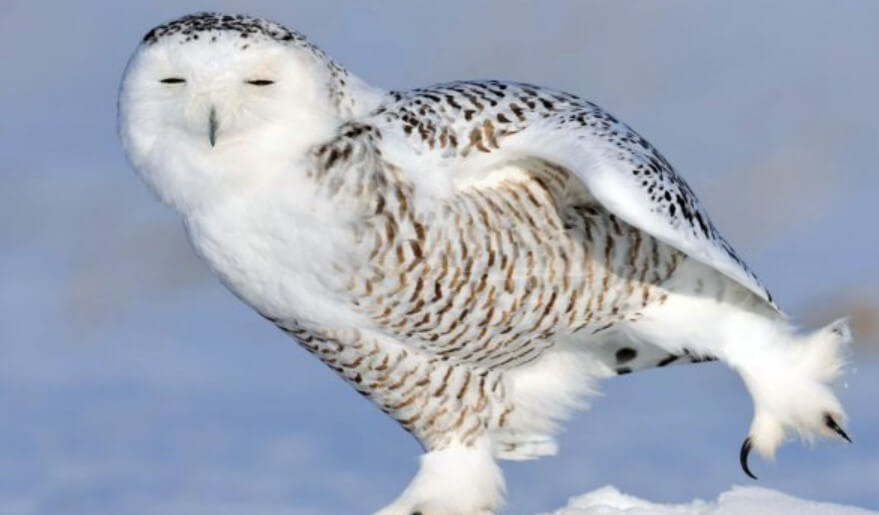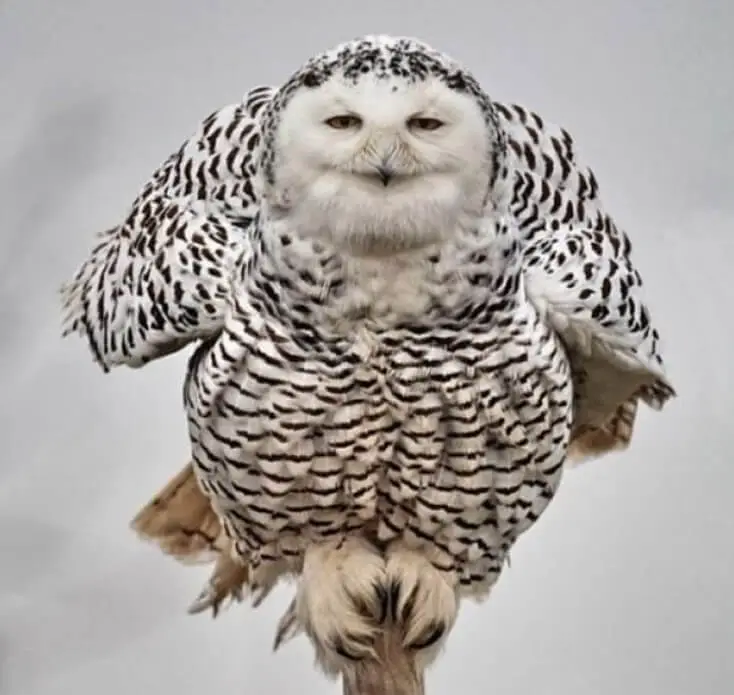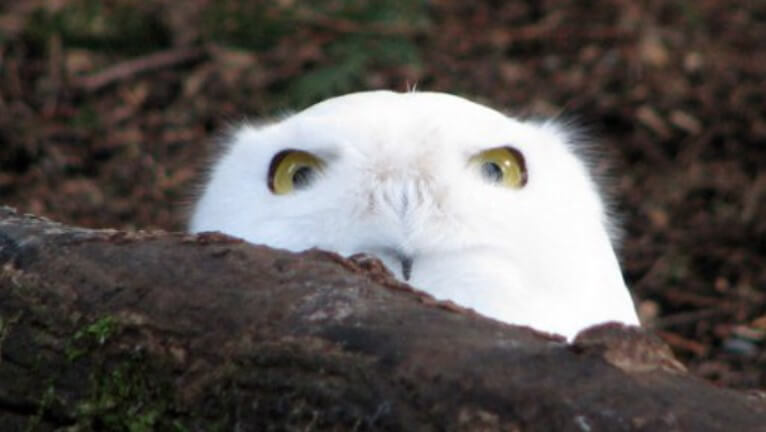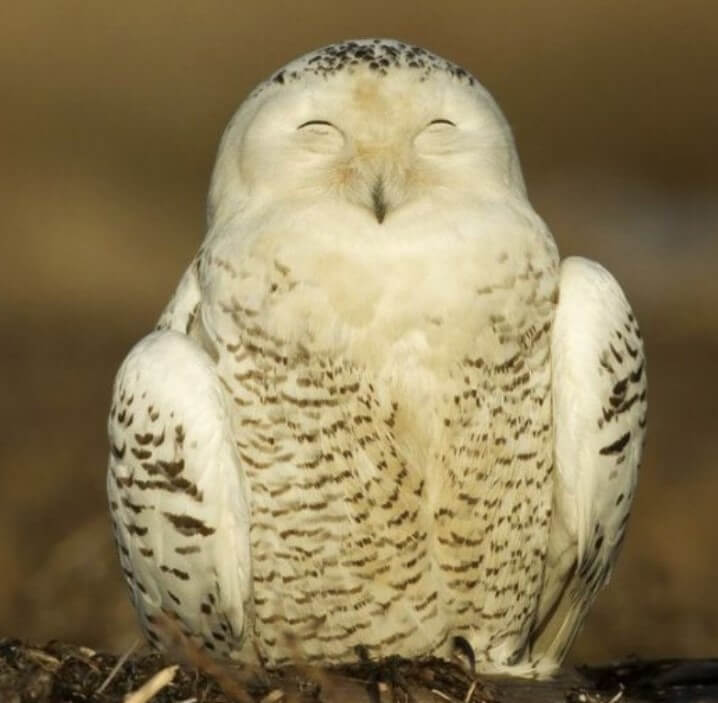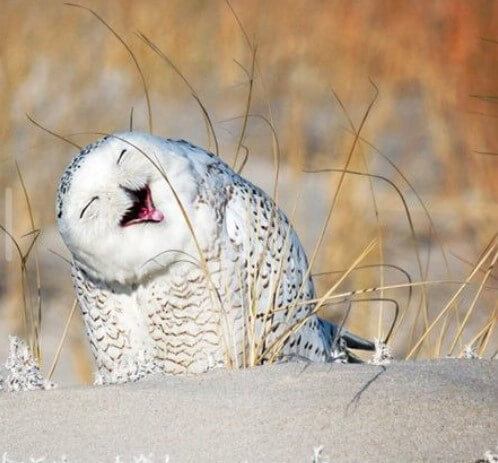Almost any child to the question: “What northern animals do you know?” among others, says – a snowy owl. This is no coincidence because the white bird has become so widespread across Eurasia and North America that it has become one of the symbols of the north. She is even depicted on the coats of arms of some circumpolar cities.
Origin of the Species and Description
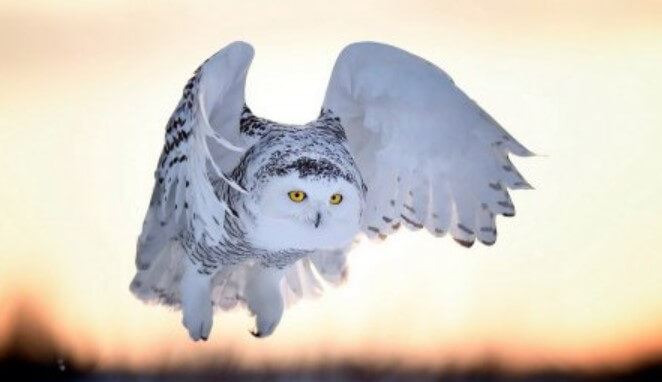
The snowy owl or as many call it, the white owl belongs to the genus of eagle owls, a family of owls of the order of owls. The bird received its second name for its white plumage, which is widespread throughout the body. In the original classification, this species was included in a separate genus, but modern biologists believe that the snowy owl belongs to the genus of owls.
According to paleontological data, the common ancestor of all owls lived about 80 million years ago. Certain species, including probably the snowy owl, became widespread 50 million years before the appearance of a man. One of the proofs (but not the only one) of their antiquity is the fact that they are common on separated continents, and have the same appearance, although the owls themselves never fly across the ocean.
The features characteristic of all owls include the fact that they do not have eyeballs, so the eyes are more similar in structure to telescopes. The eyes cannot move, but evolution compensated for this deficiency with the mobility of the head, which can rotate almost a full turn around the neck (to be precise, 280 degrees – 140 in each direction). In addition, they have very keen eyesight.
Owls have not two, but as many as three pairs of eyelids, each of which performs its own function. One is needed to blink, the other to protect the eyes while sleeping, the other is used as car wipers to keep things clean.
The Appearance and Behavior
The snowy owl is very large against the background of the rest of the tundra birds. Its average wingspan is one and a half meters. The maximum known size reached 175 cm. It is interesting that this is one of the few species in which the females are larger than the males. In particular, their body length ranges from sixty to seventy centimeters, while the maximum size of the male is only 65 centimeters. The bodyweight of females is also greater – about three kilograms. Males weigh on average only two and a half kilograms.
The plumage of the Snowy Owl is very dense and quite warm. Even the legs are covered with fine feathers that look like wool. Small feathers also hide the bird’s beak. This is due to living in conditions of fairly severe cold weather. In addition, owl feathers have a special structure with a swirl, so that they can fly almost silently. Another feature is that the white owl sheds with the change of seasons. It begins to shed its old plumage at the beginning of summer and the second time a year at the end of autumn.
The color, as can already be understood from the second name of the bird, is white. It is fully consistent with the polar owl’s habitat. Due to the fact that it merges with the snowy background, the owl remains invisible to predators and to its victims. Scientifically, such a color, corresponding to the background, is called patronizing. There are dark spots on the plumage. Their location is unique to each bird, like fingerprints to humans.
The bird’s head is wide and rounded, with small and almost imperceptible ears. But with its small size, the owl has excellent hearing and is able to hear rodents even at great distances. An owl is believed to have four times better hearing than a domestic cat. The eyes are round, bright yellow. There are no eyeballs, like other owls. Fluffy eyelashes can be replaced on the eyes. The beak is black, but invisible, as it is hidden by feathers. Owls have no teeth.
Interesting fact: the head of a snowy owl is very mobile and can easily turn at least 270 degrees. This helps the owl a lot when hunting.
Where Does the Snowy Owl Live?
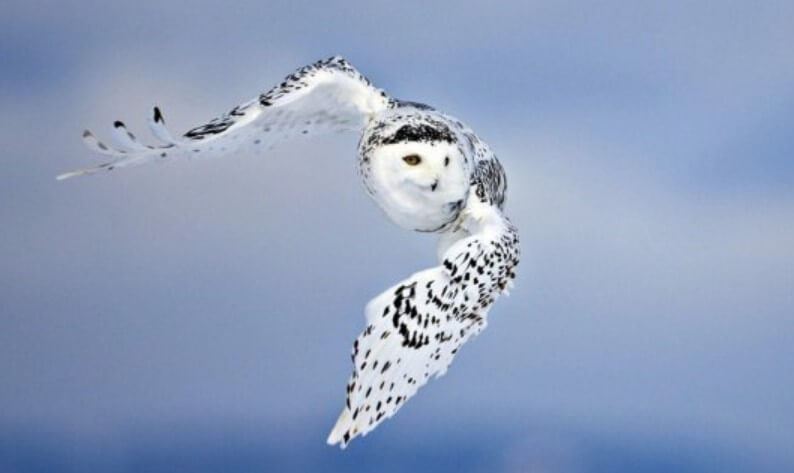
This bird is a typical inhabitant of northern latitudes, moreover, in both hemispheres. Its habitat extends in the tundra in the territories of Russia and Canada.
Individuals are found on the islands of the Arctic Ocean, including:
- Novaya Zemlya;
- Svalbard;
- Wrangel Island;
- Greenland.
In fact, snowy owls inhabit the entire Arctic. Previously, birds were also found in Scandinavia, which is reflected in the Latin spelling of the name of the bird Nyctea scandia. But now they are very rare guests there.
The bird is partially nomadic. That is, it has wintering and nesting sites. But some individuals prefer to stay in nesting places for the winter. At the same time, they choose areas that are not heavily covered with ice or snow. Snowy owls migrate in the middle of the calendar autumn, then they return back in late March or early April. Sometimes, but very rarely, birds fly into regions considered to be southern. For example, snowy owls have been seen in the Khabarovsk Territory, Northern Japan, and the Korean Peninsula.
The owl prefers to settle mainly in open spaces, sometimes among small mountain hills, since it does not fly above 1000 meters above sea level. On the other hand, the snowy owl tries to avoid woodland, sticking more to the tundra and forest-tundra. This is due to the inconvenience of hunting in places with high vegetation. In times of famine, it happens that birds fly into villages in search of food, but this happens very rarely.
What Does a Snowy Owl Eat?
The snowy owl is a typical carnivore. She eats only animal food and never eats any plants. She usually eats at least four rodents per day. An adult cannot get enough of a smaller amount. In a year, an adult owl eats about 1600 mouse-like rodents, mainly lemmings. Owls swallow small animals whole on the spot, and before eating large prey, take them to themselves, and then tear them apart and eat the pieces separately. The owl regurgitates wool and bones.
In addition to rodents, the food for the polar owl is:
- hares;
- pikas;
- ermines and other small predators;
- baby polar foxes;
- ducks and small geese;
- partridges.
All other things being equal, in summer, the white owl prefers to feed on small rodents. It usually hunts large (relative to its own size) animals in winter. Many snowy owls have also been spotted eating fish. In addition, in winter they do not disdain carrion.
Interesting fact: The snowy owl hunts from the ground. She settles down on high ground and watches. Seeing the prey, it flaps its wings sharply, then flies up to the rodent and grabs it with its claws. But sometimes the snowy owl uses another method of hunting – on a low-level flight.
If the prey is initially larger than the owl itself or their sizes are comparable, then, flying up, it bites into the prey and hangs on the victim until it stops resisting. Then the bird beats the victim with its beak. This is how the hare hunt happens.
Hunting usually begins at dusk, but the white owl cannot be called a strictly nocturnal bird. Hunting departures can also happen in the early morning after a long break. Unlike other owls, the white owl is not entirely afraid of sunlight.
Lifestyle
White owls usually live far from humans, so not everyone can see them. The bird, like any strong predator, has its own disposition. She is very strong and resilient. Almost all snowy owls are solitary. They create pairs only for the breeding season, and only at this time they act together.
Owls can make sounds to communicate with each other and to scare off enemies. The sounds are similar to croaking, hooting, and sometimes squealing trills. Owls communicate with each other only during the breeding season, so they are usually silent.
The owl spends most of its life either in a dream or tracking down prey. An interesting feature of the polar owl is that it is able to lead a diurnal lifestyle. The rest of the owls hunt only at night.
Owls are mainly hunted by lemmings and other mouse-like rodents. By exterminating rodents, snowy owls strongly regulate their numbers. The benefit of this is that in this way they are directly involved in the formation of the tundra ecosystem. Another important ecological significance of owls is that they are a factor in the successful nesting of other Tundra birds.
Interesting fact: Snowy owls never hunt near their nests, while they fiercely defend the area around them within a radius of about a kilometer. Some birds, such as seagulls, know this feature and especially nest next to owls to ensure that they guard their nests at the same time.
Social Structure and Reproduction
Since polar owls are lonely, they do not have any kind of social structure of their own. During the nesting period, they create monogamous, but often disposable pairs. The mating season for snowy owls falls in the middle of the calendar spring.
As a sign of courting the female, the male brings her food, flies around her, flapping his wings strongly, and walks alongside, ruffled. Usually, the gift is a lemming carcass. To attract the female, he can also arrange demonstration races, running over the hills, sometimes humming a variety of sounds.
If the female agrees, then the couple begins to take care of the future offspring, for which they build a nest. The nest is very simple. It settles on bare ground, for which the bird pulls out a hole or a small depression with its claws. Additionally, the nest can be lined with dry grass, rodent skins or old feathers and down. Owls usually nest on dry slopes. On the islands, nests are built on the ledges of coastal cliffs.
Owl eggs are laid not at the same time, but in turn. One egg a day. Although this interval can be much longer, reaching a whole week. Therefore, chicks in the same nest are always of different ages. Females hatch eggs for a whole month. Chicks hatch in the order of laying eggs. For the period of incubation, the male takes on the responsibility of foraging. But later, when there are many chicks, the female joins the hunt. Usually, the female stays in the nest and protects the chicks and eggs from the encroachments of predators.
Interesting fact: In well-fed years, the number of chicks in each nest can reach 15. In unsuccessful years, approximately half the number of eggs are laid, but there are also cases when the brood does not appear at all.
Owlets are usually quickly adopted. Their eyes open on the tenth day. Usually, at the same time, they become overgrown with gray-brown fluff, which will then be replaced during the first molt. They themselves begin to crawl out of the nest, and after a month and a half, they try to take off. They come to puberty in a year. The total life span of a snowy owl usually reaches from ten to fifteen years. In captivity, owls live up to thirty years.
Natural Enemies of Snowy Owls
Since the snowy owl looks like a very large bird against the background of other inhabitants of the tundra, it is very rarely attacked. But, nevertheless, the white owl also has enemies, since its chicks remain under threat from predators. The hatched chicks are often hunted by Arctic foxes and foxes, and sometimes by skuas. Arctic foxes also like to climb into nests to eat owl eggs. Due to the fact that the clutches of owls and their brood suffer greatly from the foxes, the foxes are considered the main enemy of the white owl.
Sometimes the death of chicks is due to the aggressive behavior of the older ones. Large chicks are able to destroy a younger brother, and then even eat. But cannibalism is usually very rare for them. Very often, young owlets die of hunger due to the fact that older chicks take away the food brought by their parents from them.
Predators hardly hunt adult owls, but if this happens, the owl spreads its wings wide and frightens the enemy, demonstrating false attacks. More often, snowy owls simply fly away from predators, having heard or seen an enemy on the way. If it happens that an adult owl is caught by a polar fox or another predator by surprise, then it simply falls over on its back and fights off the enemy with its clawed paws.
If the enemy attacks the owl’s nest, then she tries to block his path in order to protect the chicks. It flaps its wings in front of the predator’s muzzle, periodically flies up, and then falls on it, grabbing it with its claws. Usually, such measures are sufficient.
Population and Status of the Species
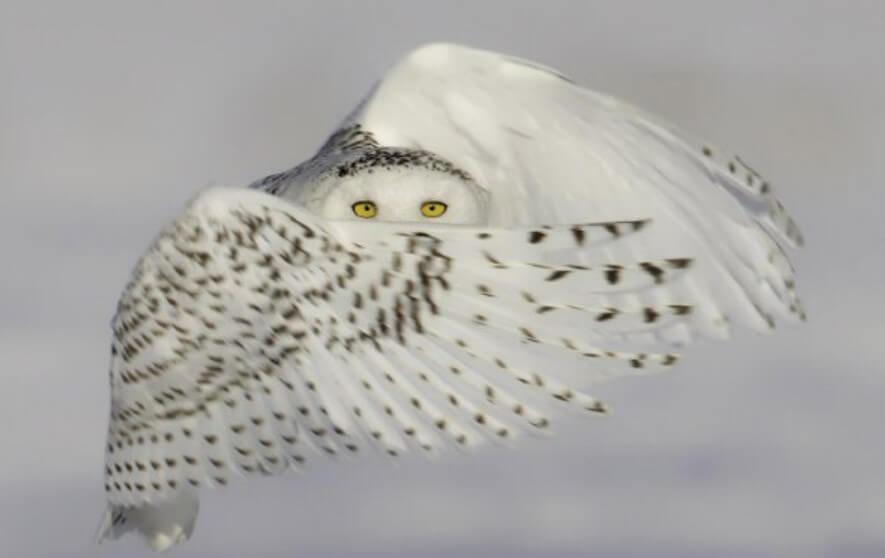
Today, snowy owls are a rare species. In North America, the total population has declined by 53% since the mid-1960s. There is reason to believe that the picture may be similar in Russia and the northern parts of Europe. What is known for certain is that in the usual habitats, the number of birds has noticeably decreased, and they have become less common.
The species has the status of vulnerable, but so far they are not threatened with extinction, and no additional measures have been taken to protect snowy owls. The average nesting density of these birds is about fifty pairs per hundred square kilometers. The world livestock numbers about 28,000, which is quite a lot. But some scientists consider these data to be highly overestimated and suggest that the snowy owls will soon receive the Red Book status.
It is not known for certain what exactly caused the decline in the number of snowy owls. Climate change can play a role in this, as it affects the size of the food supply. Some damage to the population is caused by human activities. It happens that a snowy owl dies in traps. Traps in many areas are specially set up by hunting hunters. Owls also die in North America when they collide with cars or high voltage lines.
Rare Snowy Owl Appears in Central Park!
The last time the arctic owl was seen in New York in 1890.
Some New Yorkers were lucky enough to see the rarest snowy owl; She was spotted in Central Park last week and is back this week!
The owl, which is common in the more northerly areas, hasn’t been seen in New York since 1890! And now she was spotted twice, one week apart. This is reported by the specialized resource Manhattan Bird Alert. They said they spotted a bird in front of the Central Park reservoir.
An account reporting the city’s rare birds and sharing photos and sightings (they were the first to announce nearly every rare bird in Manhattan since May 2013!) Says the owl will likely linger in Central Park due to the vast selection for hunting – the place is teeming with ducks and mice.
Though unlikely, they report that the owl may have been in Central Park all week unnoticed. “The initial arrival was absolutely incredible, as was the return!”
So, while walking in Central Park, be careful: the predator can return to the park to hunt at any time. Suddenly you are lucky enough to see a bird that has not arrived in New York for 130 years.
Female Snowy Owl Names
Abel, Abra, Augusta, Augustine, Ada, Alika, Alina, Alice, Alicia, Alpha, Ama, Amalia, Ariadna, Ariana, Asta, Astarta, Astena, Asya, Aphrodite, Akhta, Achcha, Achchi, Asha, Ashika, Aelika, Aelita Baccarat, Bassi, Basya, Betsy, Bijou, Brenda, Brenta, Brett, Britain, Britney, Britt, Britta, Bead, Bootsy, Beauty, Bella, Batsy Viola, Vendee, Vanessa, Wanza, Varya, Vesta, Viola, Virginia, Virginia, Vlada, Vladislava, Vladlena, Vlasta, Volta Gabby, Gaida, Gamma, Geisha, Hera, Gerda, Giselle, Gears, Gloria, Dreams, Great, Gressy Dakki, Damka, Dana, Dara, Dasha, Degira, Desi, Desira, Deniza, Deya, Jaga, Jackie, Gela, Jerry, Jessie, Jessica, Judah, Judy, Julia, Julia, Dixa, Disa, Dolari, Dolly, Dorry, Dusya, Smoke, Dera Eva, Egoza, Erika, Yerma, Eshka, Jacqueline, Jeannette, Jeanne, Zella, Jerry, Jerica, Jerry, Josephine, Jolly, Zhudi, Juzha, Zhulba, Zhulga, Zhulia, Murmur, Juliette Bully, Zara, Zarella, Zaura, Zeya, Zina, Zita, Zlata, Zora, Zuza , Zulfiya, Zura, Zurna, Zusya Ivita, Ida, Idzhi, Isabella, Isis, Isolde, Ilva, Inga, Inessa, Toffee, Irlotta, Irma, Irena, Ista Kalma, Kama, Camellia, Cameo, Kamila, Kana, Kapa, Kara , Karina, Carmen, Kasia, Katyusha, Kerry, Ketris, Ketty, Kzhela, Kisha, Klara, Button, Koki, Cora, Chris, Krystal, Christie, Crazy, Ksyusha, Kat, Katie Lavrushka, Lada, Ladi, Laima, Lally, Lamia, Lana, Lanara, Lady, Leila, Lesta, Lika, Linda, Lola, Londa, Laura, Lawrence, Lot, Lusha, Lala Magdalene, Madeleine, Malvina, Mania, Marquis, Masha, Meggie, Mary, Miki, Milady , Mini, Mirra, Myrtha, Michelle, Monica, Murza, Maggie, Ma’am, Maris Navara, Nadira, Naira, Nani, Nancy, Neji, Nelly, Nelma, Niagara, Niveta, Nika, Nymph, Nita, Nora, Norma, Nyama Oda , Odette, Olivia, Olympia, Ollie, Olsi, Olvia, Onika, Ormella, Ornetta, Ophelia Pandora, Pani, Pa rcella, Patricia, Peggy, Penelope, Penny, Pitta, Pride, Prima, Pass, Paige, Perry Rada, Radiana, Razina, Ryda, Ralph, Rummy, Rachel, Raya, Regina, Rima, Rimma, Rita, Rozia, Roxana, Ruzana , Ruta, Reji, Radi, Russi, Sabrina, Saga, Saji, Sally, Sandra, Sunny, Santa, Sara, Sarma, Sarochka, Selena, Setta, Cindy, Signora, Siren, Snezhana, Sonnet, Susan, Suzanne Taira, Thais, Tanyusha, Tara, Thames, Tera, Terry, Tertsiya, Tessa, Timona, Tina, Tisha, Tomila, Tora, Tori, Troy, Tuma, Turandot, Terry, Tyusha Uganda, Ula, Ulana, Ulli, Ulma, Ulmar, Uma, Una , Undine, Urma, Ursa, Urta Faina, Fani, Fanny, Farina, Felika, Fairy, Flora, Franta, Francesca, Frau, Frezi, Friza, Fury Haneta, Hanni, Helma, Hemmi, Khiva, Hilda, Chloe, Juana, Hella , Harry Tsatsa, Ceza, Celli, Cerri, Cecilia, Tseya, Tsiana, Tsilda, Tsinia, Cynthia, Tsypa Chazeta, Chana, Changa, Chanita, Chara, Charina, Chauna, Chacha, Cesara, Cherkiza, Chika, Chilesta, Chilita, Chinara , Chinita, Chita, Chucha Shammi, Shani, Charlotte, Shahinya, Shane, Sheina, Shella, Shelley, Shel da, Shendy, Sherri, Shusha Ewald, Ega, Aegis, Eji, Eli, Ellada, Elba, Elsa, Elfa, Emma, Ena, Era, Erica, Earley, Esta, Esta Judita, Yuzhana, Yusefa, Yucca, Yuma, Yumara, Yuna, Junga, Yunoro, Yurga, Yurena, Yurma, Yusya, Yuta, Yutana.
Male Snowy Owl Names
Abrasha, Alex, Albert, Alf, Ara, Arik, Aristarkh, Arkashka, Arkhip, Archie, Archibald Berik, Berkut, Billy, Borka, Boris, Bush, Buyan Venya, Willy, Vinch, Vitka, Vovka Gavr, Gavryusha, Guy, Galchenok, Ganya, Garrick, Hermes, Gesha, Goblin, Gosha, Grill, Grinya, Grisha.
Cute Snowy Owls
The snowy owl is the largest bird of the order of owls. And also – this is a very beautiful bird, which causes admiration and delight.
